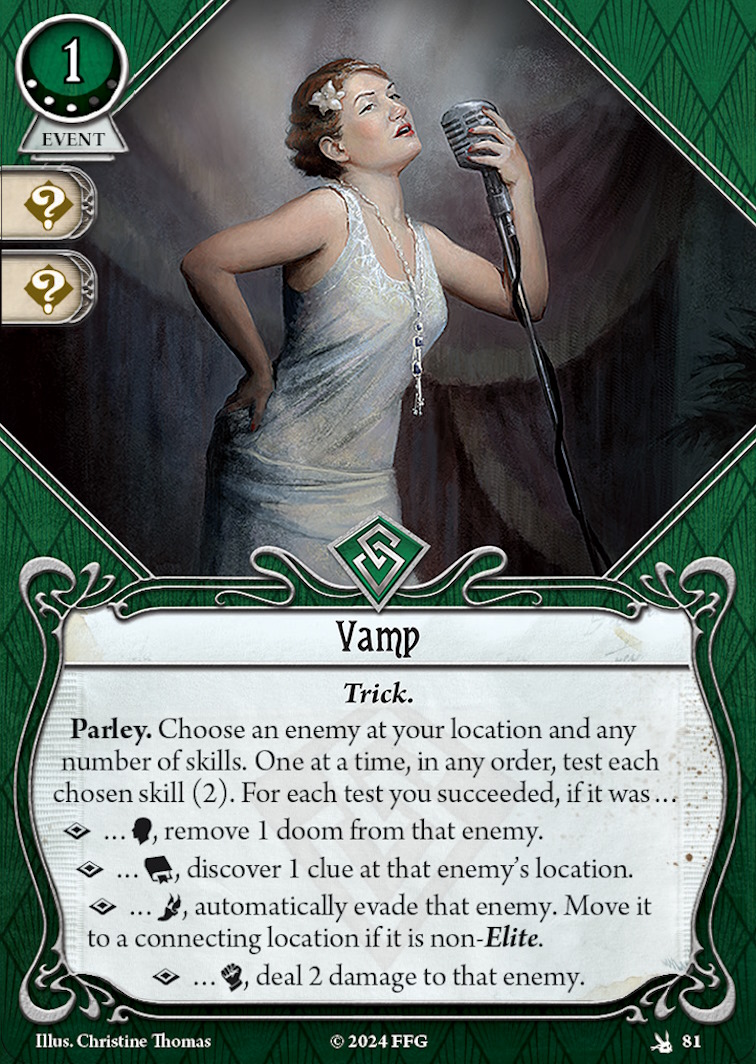
I thought I'd write up a quick review of this card, since I think it's by far the best card in the TSK expansion and one of the best in the whole game, period, and none of the other reviews quite capture that.
What makes Empirical Hypothesis so good? Well, at level 0, if you just choose the "succeed by 3" mode every turn (as most users of this card will want to do 99% of the time), you have basically a slotless Lucky Cigarette Case that requires success by 3 instead of 2. (There are also other more subtle differences, like this can't trigger the turn you play it, and the draw is banked for when you want it--I'll discuss that later.) That's a heck of a card! Lucky Cigarette Case is a great, and still great when you have to succeed by 3. Doing so once a round is a natural occurrence for Seekers, who have great Intellect stats and want to investigate a lot, often multiple times a turn. In fact, even investigators who can't go beyond Seeker 0, like Finn Edwards and Norman Withers, should be interested in this card despite not being able to buy any of the customizations.
Okay, so what about the upgrades? In my view, the ones that spend evidence for alternative benefits (Research Grant and Irrefutable Proof) are not that good--the rate you get is not better than 1 evidence for 1 card, and you don't really need more than one payoff for your evidence. Plus, the power of card draw is that the cards you draw will do things--i.e., they'll find clues and generate money for you. If you draw a ton of cards, that's kind of all you need.
A key upgrade is Peer Review, which a) lets any investigator meet the criterion, and b) allows anyone to spend evidence to draw cards. Both are excellent and go well together. When your teammates can meet the criteria, it becomes trivial for this to trigger once a round (and with further upgrades multiple times a round), and at that point this spits out so many free cards for the team that you won't need them all, at which point it's very powerful that your teammates can tap into the cards.
Then you want Alternative Hypothesis and a couple more of the criteria: in the dark, I'd recommend Field Research and Independent Variable as the most generically applicable, though some investigators will prefer different ones. With these in tow, an average of two evidence per turn is easily achievable. That means 2+ extra cards per turn flexibly distributed throughout the group, which is grossly overpowered.
The fact that Empirical Hypothesis lets you bank the cards as evidence, which you can draw whenever you want, is super powerful for a number of reasons:
- Because the cards are essentially stored as evidence, you get around hand size limits.
- If it wouldn't be an opportune time to draw your weakness, you can hold off until you're in a spot where you can deal with it.
- It lets you save your draw until an enemy arrives and machine-gun it down with Ancient Stone: Knowledge of the Elders.
- If you have Peer Review, you can hold off on allocating the draw until it becomes clear which team member can make the best use of it.
- You get to trivialize a notorious Forgotten Age Scenario.
There are plenty of investigator-specific synergies to be mentioned, for example:
- Darrell Simmons has further uses for the evidence.
- If Carolyn Fern is using Field Agent every turn, she can easily trigger Trial and Error that way.
- The delayed draw helps optimize Harvey Walters' investigator ability, ensuring you never miss a turn of bonus draw.
- It also helps Norman Withers optimize his own ability by better controlling the top of his deck.
Two more notes. First, if you're looking to optimize, don't get greedy and run only one copy of Empirical Hypothesis. Yes, you can only have one in play at a time, but if a card virtually wins the game for you, far better to draw a redundant copy than not find it in the early part of the scenario. Second, this card can massively slow the game down, and it's also easy to forget choosing a criteria at the start of the round. I recommend making a quasi-house rule whereby if you forget to declare the criteria, assume that you defaulted to "succeed by 3." This helps smooth over some of the play experiences with this card.




